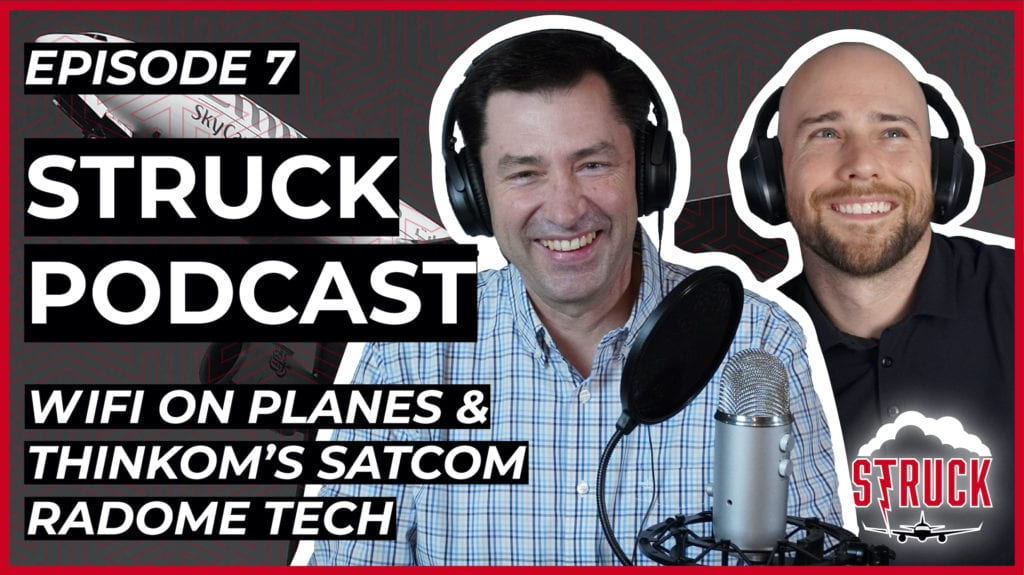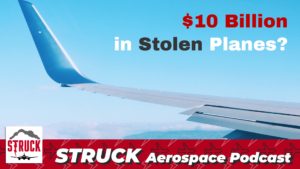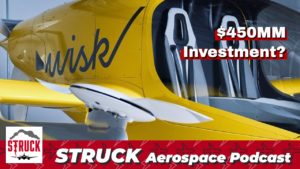In episode seven of Struck, we discuss Panasonic avionics’ white paper about millennial travelers, and whether WiFi should be free on all flights. We also talk about ThinKom’s satcom radome technology and how their antennas help make in-flight WiFi a viable solution for travelers.
Learn more about Weather Guard StrikeTape segmented lightning diverter strips. Follow the show on YouTube, Twitter, Linkedin and visit us on the web. Have a question we can answer on the show? Email us!
Podcast: Play in new window | Download
Transcript
Dan: Welcome back. This is the Struck podcast,episode seven. I’m your cohost. Dan Blewett. I’m joined here remotely by lightning protection expert. And CEO of weather guard, lightening tech, Allen hall. Allen, how are you doing?
Allen: Great. Dan, how you been?
Dan: I’m doing well. Um, I feel like this has been like a little bit of an easier, slightly more focused week for me.
I don’t know why it’s rained a lot of the week, but overall pretty good. How about you?
Allen: Uh, we’ve been getting in and out. You know, we’re sitting at this new manufacturing facility, so we’ve been running around back and forth quite a bit. But, uh, you know, it’s still pretty quiet. All the shops are still closed.
All the restaurants are still closed, so there’s really no place to go. Have you been over to the Walmarts in D.C lately? Has
Dan: To what? To get pepper sprayed? No, I have not. I have not. Um, and then we talked about that story, although it might’ve been cut out of this, out of the episode, but. Yeah. Yeah.
What, what your Allen’s alluding to for you listening as a, there was a story in DC that he sent me that a woman was getting onto the elevator at a Walmart, which, you know, in cities there’s Walmarts with you on the second, third floor, they might occupy a number of vertical floors and have parking beneath them, or loft apartments above or below, whatever.
And a woman was getting into the elevator and other other people were trying to get into the elevator to, you know, like as people do, and she’s like, Oh no, you’re not coming to my elevator. And she pepper sprayed. So another woman and the cops were called, and then like her, the statements from her were just unbelievable.
She’s like, Oh no, you’re not going to get in my,
in my elevator gave me that Corona virus.
It was just like straight out of Jerry Springer and it was an amazing story. I showed up my family
Allen: and that hasn’t spread has it? I mean, Oh, they nailed the target. Do you guys have Kmart? I guess Kmart is closed or what?
Dan: I mean, Kmart does not exist in Washington D C um, I don’t. I have Kmarts have been going out of business for a while. I think they still are a thing, but like kind of not really.
Allen: Just lost a harvest. Yeah. We just lost ours
Dan: North of here. I mean, DC is a pretty affluent little city, so Kmart, I don’t know who’s going to Kmart, but, but yeah.
But the interesting piece of news on my end is I ordered my groceries for the first time ever the other day ordered Costco did. Yeah. Okay. It was glorious. It was glorious. Sy, my, my sister has been, I mean, rightfully so. My sister’s, uh, she’s due with her second child in two weeks, and so she earns the family like, Hey, it’s a complicated situation because, um, she’s afraid that her and her husband are gonna maybe contract something at the hospital right after she goes birth.
So she doesn’t want to come home with her new baby greet my parents. You know, everyone wants to see the baby, and then my parents get something from them because they’ve been in the hospital. So it’s kind of like they’ve been asked, they’ve asked us to, Hey, can you guys all quarantine for two weeks before, um, the birth?
And then we’re really just probably not going to see them for the first two weeks after, so they can sort of quarantine and be their own little family unit in the house. Um, right when they get home with the new baby. So it’s kind of a, it’s kind of a. Crazy situation. But anyway, she urged us to please do everything possible to minimize contact with the outside world.
So I ordered my groceries, which was like a, I guess probably a $35 upcharge, all told.
Allen: Wow.
Dan: Okay. It was like eight bucks service charge, $8 delivery fee. Um, I tipped the guy $15. It’s not a short trip over here from, um, across the way in Alexandria, Virginia. And then, um. And then they Mark up some of the prices, but not others, which is, which is interesting.
And I don’t understand their algorithm because I’m a very, I’m not like a, I’m not like overly worried about price when I shop, but I know what everything costs and what it should cost. I would guess a year, probably the same way you said. Engineers are very much like, they know if they’re getting, we know exactly know everything.
And I’m the same way too. So like I know like I love fruit and I know. I’m very opportunistic about, you know, what, the bright prices that I’ll buy grapes at or blueberries or oranges. I don’t pay more than I, I know I should for any given item. And so looking through the, as you’re shopping on the app or on the website, it’s a, you know, you’re like going through all your items and you’re like, Oh, this is like a lot more than it normally is, or this is like, seems like it’s the same price and you assume that everything was going to be like marked up like 5% or 10% or something to account.
That’s probably how they get their fee. But in reality. Some things were not marked up at all, it seemed like, and others were marked up almost double. It was really, really strange. Hmm.
Allen: What was the company we’re buying the groceries from? What was, what was the grocery store?
Dan: Well, it was Costco and, Oh, it’s Costco.
Yeah, but it’s through Instacart, so, Hmm. But yeah, so like for example, I got a five pound bag of frozen tortellini. Which is usually like $12 and it was like $12 and I’m like, okay, that’s a big item, kind of heavy, like big volume. And then I got a one pound thing of a organic spring mix, which is usually four 49 and that was seven 49.
I don’t know where you’re laughing right now. But um,
Allen: cause that’s a lot of food. Five pound bag of tortellini is over. You just
Dan: said it’s great to have in your freezer. That’s not a waste cause it’s got a week’s worth of food. Yeah. I mean that’s a month’s worth, but it’s great to have your freezer, two minutes, two minutes and some boiling water.
But like why would the huge bag of pasta be basically the same price it normally is, but then the spring mix is seven 50 instead of four 50. That’s the, maybe that’s Corona free. I don’t know. They went in there and extra wash
Allen: my wife, I had home some fruit that came, had a label on it. Came from Northern Northern Italy.
I thought, man, they must be, have a hard time unloading produce that came from
Dan: Northern smallpox blankets right there.
Allen: It was Kiwi, which I didn’t really. Connect. Yeah. I guess that makes sense to me. Northern Italy, it’s a good place to grow fruit like that. It’s so my daughter chimed in like what the, what are we buying fruit for Northern Italy from your cause it’s on discount cause no one wants to buy it right now.
Yeah. So I thought that, I thought that was cute. You know, people get very sensitive about that. Um, cause they know where the coronavirus has been. So any products that come out of there, everybody’s real cautious about. I guess that makes sense. Short term, but longterm it’s, it’s kind of ridiculous, right?
Yeah. Um, and that, that fruit had been on a ship for probably two weeks before it got to us. There’s no way that it’s going to be contagious all clearly. But you know, that’s not the way people always think
Dan: it’s like a Trojan horse, but, but oranges or grapefruit or whatever.
Allen: We did America one piece of produce at a time.
Dan: Exactly. But I mean, that is interesting. Like I bought a bag of oranges and they’re fantastic, but. It’s, it’s the time of year where it should not be orange season. Like you shouldn’t be able to get oranges that tastes good at all right now. Right? Like it’s, it’s, I mean, citrus season’s November,
Allen: I thought it was in the spring or is it late?
I think dilemmas are produce all year round. I don’t know about oranges. I think lemons, lemon trees will produce all year round. I think oranges can be kind of year round. Right? It’s not, it’s not a, it’s not a fall food. I’m pretty sure.
Dan: Well, it’s, I mean, citrus season in Florida, I’m pretty sure is. The winter because we would get, uh, from like my dad’s rotary club.
Raise a lion’s club, one of his like, you know, public service clubs always did like a big, uh, straight from Florida, like the best, like G, just the best oranges and grapefruits peak. Yeah. And that was always in like around November-ish. Um, and then they seemed to just like kind of get crappy around February, March.
But now, I mean, California I think grows them probably more year round and they’re coming from all over the world and all over. Of course, you don’t know, watermelons are still not knock it out of season. No. And we’re getting close. Getting close. It’s almost watermelon season,
Allen: so yeah.
Dan: Exciting
Allen: time.
Oklahoma has a really good watermelons. I think it’s the end of July, early August. And when they’re at their peak. Yeah, that’s good. Eaton?
Dan: Yeah, up in here in the Northeast, although I guess I’m more like just the I, I actually don’t like, so I should explain that. I called DC the Northeast the other day and someone corrected me.
And it’s really the mid Atlantic, but Atlantic, I don’t know, maybe it’s not the, I don’t know. You’re in Massachusetts. Does Maryland count count as Northeast or now
Allen: while we’re in new England.
Dan: Okay. Yeah, definitely. That’s true.
Allen: The original colonies, I suppose, but I mean, it’s so new. England has everything except me.
They can do the Northeast. It’s everything except New York state.
Dan: Okay. Okay. Which is
Allen: odd, but yeah. They call, it gets considered as new England. It’s kind of like a, I always think of the Midwest when I say the Midwest, people get really antsy, so I grew up in Nebraska and so we always call it the Midwest, Kansas, Nebraska.
Oklahoma would be considered mostly the Midwest, different from local standpoint, but people in Ohio considered. Them to be the Midwest. We’re the Heartland. It’s a big thing. Why that even matters. I don’t know why we’re the Heartland in Nebraska. Beats the heck out of me. It seems like we’re kind of in the middle of the country, so we should be the Midwest, but
Dan: whatever.
Yeah. I don’t consider Ohio to be the Midwest. I don’t know. I know it’s not far enough. It’s too close to
Allen: where the guy. Yeah, no. I got off the kitchen with the professor one time about what? With the, I had written it a paper or something about the Midwest. He goes, well, the Midwest is Illinois and Ohio and Indiana.
Dan: Yeah. I think it’s, I think it’s Illinois and over Illinois and then to the West.
Allen: I wa, I mean, I would clearly would fall into that category. South Dakota, Nebraska, Kansas, go up and down North of South there. Texas is its own thing, but
Dan: yeah, yeah, yeah, yeah. That’s, that’s an interesting, uh, breakdown. But I mean, I guess Ohio kind of that border one, cause Ohio borders, Pennsylvania and Pennsylvania is certainly not the Midwest.
Um, and Ohio is pretty expansive, like West to East. I feel like I’m trying to,
Allen: Ohio is flat. It’s like the first place where you kind of like, okay, we’re sorta in the quote unquote Midwest cause it’s farm country. He got there and it was corn fields and corn fields and uh, it reminds you of Iowa in some level.
It’s, it’s diff, slightly different climate, but it’s kinda like driving dry wall in the middle of July. There’s a lot of corn out there.
Dan: And so then kind of looks like this Kentucky in the Midwest then that’s right below Ohio. I feel like it would have
Allen: to know, you know, I don’t know what we can consider a Kentucky, uh, yeah, it’s right across the board.
Dan: Yeah. This is getting in a very nebulous geography.
Allen: We’re all gonna start talking about it in terms of, uh, college football conferences. Right. And I think that’s how the United States has kind of broken up. Right. The sec, the ACC, the. Pack 10.
Dan: Yeah, that’s true.
Allen: That’s an easy word to describe it,
Dan: right? Yeah.
Yeah. So today we’re chatting about a bunch of different, uh, some interesting new technologies. The first one on our list, Allen Uber, elevate the future of urban mobility. Have you seen these, uh, these, these little choppers? I guess they’re potentially going to be electric, maybe unmanned plan for 2023 they say between suburbs and cities.
I thought
Allen: they were piloted, but at least maybe it’s an initial versions are piloted a fancy helicopter, right? Uh, it’s, it’s electric driven. I think that’s the goal, to keep them to be a clean energy device. Um. Yeah. I don’t know if it makes much sense to me. Uh, the complexity of having multiple motors versus one gas driven turbine or two turbine engines that are turning a rotor.
It’s six one half dozen. The other, to me, it’s pretty much the same thing. I don’t know. You know, obviously in all these things, it’s all about reliability and safety. So those types of aircraft haven’t. Don’t have any track record yet. Real helicopters. We pretty well understand at this point. So anytime we introduce something new like that, it’s going to go through, uh, some teething pain and I kind of wonder what’s going to happen here.
Dan: We’ll just, from a company standpoint, I mean, we talked a little bit off air about this, but. Uber has never been profitable. They’re not even close. No. Do you feel like this, uh, I mean, is this, is helicopters going to pull them out of the throngs of
Allen: no, I come on the ride. Aviation is just like racing, right?
And how do you make a small amount of money and racing? You start out with a larger amount of money. You always burn cash in aviation and in racing cars, there is no way you can make. Moodle’s of money in anything that’s aviation related without having some sort of great technology product that drives huge demand.
And I’m not sure, even in an Uber situation, they will be driving a huge demand, especially with all the, you know, pretty much all transportation shut down right now. Now the question, I think from an Uber and Uber type thing, if you want to not fly in your Southwest seven 37 between Phoenix and Los Angeles.
Know. Then I think he may have some sort of argument where you want to fly solo or with a group of families, so you’re not open up to other people. There may be some advantages there, but boy, that’s a tough, tough market. It’s one of those marketing things where you always want to have the coolest product, but in aviation, that doesn’t always pay off.
It’s been in a lot of aircraft programs over the years have been really cool looking at advance, and that just. Couldn’t make it to market, or once they got to market, they couldn’t sustain themselves for a couple of years. It’s so hard. That’s why you don’t see a lot of aviation companies or larger aviation companies because it’s just such a difficult economics to make that work.
Dan: Well, and if these ended up becoming electric powered, how, how? I mean, it takes up many, many years obviously, to develop an aircraft, right? I mean, what’s the typical timeline of RA? We’re designing this five years. Five plus. So
Allen: a lot of programs I’ve worked on have been way longer than five.
Dan: So do the designs change over those course of that five years to reflect like new technology or like how do they do that?
Is it in flux like that or what.
Allen: Uh, is someone in flux the first couple of years. It’s always influx. Once you get to building the first airplane or two, it sort of locks in because the technology has to all play together. So you can’t keep upgrading technology as you go. So you kind of lock in the technology and then.
Rush as fast as you can to get the thing to marketplace. It’s hard because of all the complexity of all the systems. It is not like a old stick and rudder. Everything’s connected with cables or, or, uh, uh, it’s fabric cover airplanes anymore. They’re an all complicated device. There’s a ton of electronics and equipment inside these things and automated systems.
So the complexity drives a duration and all the testing you have to do to make sure they’re safe drives times out. It years ago to shove a new airplane out was probably a couple of years and it feels like now it’s like eight to 10 I think the Mitsubishi MRJ airplane that’s been going on longer than I can remember.
A Honda jet was the same way. Honda was in development for probably 10 years before it really started rolling. It’s not easy. It’s not easy. It’s, it’s way different than building a car, in my opinion. Just because you kind of got the foundation of a car there all the time. And the safety features are kind of prescribed when you start aviation’s different,
Dan: you gotta do a lot of
Allen: flight tests and, yeah.
Dan: And so I’m kind of wondering out loud about, you know, like the battery. So if these are electric engines, I like battery technology is just, it’s improving at a crazy speed. Right? So how do you design a plane, an electric plane? You know in year one and have it still be even, you know, relevant as far as like the battery packs and then the designed to accommodate the battery packs and the weight of the battery packs.
Five years later.
Allen: Yeah. I think the battery technology hasn’t had actually hasn’t changed all that much there. The lithium ion batteries were popular and people, aircraft companies were starting to change over to them from weight saving standpoint of having lead acid lead acid batteries to like to start the airplane or.
To run some stuff while the engines aren’t, aren’t turning. Um, that was 10 ish years ago that, uh, Lithia and I am started being used and then that’s what most of these electric aircraft are going to be running or probably lithium ion wants us just because of the weight savings. I’ve seen some that have been lead acid lead acid would still work, but, uh, uh, yeah, I’m not sure that a lithium ion is going to be the.
The final destination for all of this. Lithium is not an easy metal to come by. Obviously Elon Musk is trying to create these battery factories, which may drive down the cost of it, but still, um, I’m not sure where it’s all going to go. Uh, battery technology has been a limiting factor for most of society for the last 50 plus years.
Dan: Right?
Allen: If, if we had good batteries, we would be driving electric cars. We would, we would totally be driving electric cars or not. Right? So if you had a better, better storage battery and more efficient storage battery and one that lasted more than a couple of years, then things would be totally different than they are right now.
Dan: Yeah. Well, speaking of other technology that’s grown. I dunno, maybe slower. I would say it’s slower than it probably should have is inflight wifi. So I just read it recently, a white paper from Panasonic avionics, and they talked about how, you know, millennials are traveling in a lot different sort of way than they used to, or at least just, I guess the way they used to design their aircraft and, um, catered to guests who traveled kind of more as like big family trips.
And now millennials are taking more. Frequent, often solo trips with friends. Now it’s not necessarily with families and they’re just talking about their, their sort of demand for in flight tech. And, you know, wifi is one of the things that they’re discussing. And of course, right now, jet blue is, uh, I think the only carrier that offers free wifi.
And, um, it seems to me like that’s. That should be something that’s just free for everyone. Like that should be an incentive and just build it into the price of the ticket. But I don’t know. Where do you fall on that? I mean, I feel like wifi is still terrible on flights. I’ve, I bought a once and it was a waste of $15.
It was just trash. I couldn’t get anything done. It was so slow. Um, so that was just one experience. I think that was on Delta, but I don’t know. I mean, do you, do you, have you had good success with that?
Allen: Well,
Dan: probably two years ago. Oh, really? Yeah. Okay.
Allen: Hmm. Uh, so the, the, I use, uh, the wifi on Southwest airlines all the time.
Uh, and I pay for it every time I get on the airplane. Now, you can’t stream movies. You can’t watch a ball game with it. You can’t, uh, try to download huge files with it, but you can send an email and you can sin, you know, you could text and that sort of thing, which I think is kind of useful on a six hour flight or eight hours.
Across the country kind of thing. I think it’s useful. Uh, jet blue was really the leader in this thing years and years and years ago, because they own life TV. So they got in early. They actually had the company, it was doing a lot of that initial wifi stuff. Uh, so they outfitted all their aircraft early on.
They had the company to do what they were doing things down. And I think in Orlando, Florida is where that was based out of. And so they monitored all their airplanes and they offered why for free. Follow the JetBlue Twitter page like I do. You see that their customers really love the free wifi? Yeah.
Yeah. So their wifi is not that much different than everybody else’s. I don’t think it’s much different than a Southwest airlines wifi or some of them, like, like a Gogo I think is on Delta, and I’ve had good success with Gogo before, but I guess it depends on how many people are using it clearly. Right.
So the demand on the aircraft is based on how many people are using it. I don’t know if there’s a, a. A good way to get wifi more in use. I think that the con, the conflict that wifi is having is that mobile phones and iPads and that kind of thing are getting more and more memory inside of them. So you can shove more and more movies.
You can download an app. Plus you can download Amazon prime right to your device and then an I’ve done that and flick it on on your phone, and you could watch a movie pretty easily on the flight. You don’t need the wifi for that. And Southwest airlines also offers a lot of free movies and television shows, right, which are free on Southwest also, so that there’s a limited set of movies and a limited, and I think there’s a set of television channels you can watch live.
Watch a totally free now it’s not, you can’t send email and that kind of thing. That costs a couple of bucks, but the rest of it is free. Most people I want, I’m on a Southwest flight, I think it’s about a, I would say 40% 30 40% are probably watching some sort of free TV, what that system. But a lot of people are watching their own movie that they’re already downloaded.
So as we, as we get like the new iPhone, I forget how much memories and that thing, 64 gig, or maybe it’s more than that, 128 gigabytes inside that thing, man, you can load a lot of movies in, which then sort of defeats the purpose of having wifi. So they’re playing a technology game, in my opinion. You know, you can have the wifi and you can do the email thing, but you, you know, for a couple hours.
Does it make that much difference if you’re flying on a 10 o’clock flight from, uh, the West coast to the East coast? Probably doesn’t make any difference.
Dan: Yeah. So, yeah. I mean, I don’t, I don’t disagree with any of that. I just, I guess a question. Well, Hey, when it’s so expensive, I mean, I wouldn’t say it’s so expensive
Allen: a lot.
I think Southwest is like seven or
Dan: eight. That’s 15. 15. Yeah. Um,
Allen: is that, is that for every leg is 15 bucks? Cause for the day, and
Dan: don’t quote me on the exact price, but I’m pretty sure it was over. It was over. Like it was enough where I was like, eh, I should probably shouldn’t do this, but I’ll, you know, I’ll actually work.
I guess maybe I should. I’m pretty sure it was 15 bucks. But you know, you get burned by a once, you’re like, well, I’m not going to do that again on any airline. I mean, pretty much, cause he was like, well, you don’t know any better. How many sample sizes do you test before? You’re like, well, this is just wasting lots of my money.
You know, like, so
Allen: 15 bucks at a time is tough. And if especially every leg, you have to do that. W I by Southwest, I went every time I landed an airplane, because it’s. Part of my industry and we provide strike tape to those radio homes. Uh, I like to see how well those systems are working. So I always buy and see how all this works.
I haven’t run, I only manage the problems. This is a couple of years ago in Southwest weather. I, we were traveling to a, I think we’re going to Florida at the time. There are a lot of kids and they were playing at that man. There’s a lot of people on the wifi, so it was running not great, but that’s the only time I’ve ever had real trouble with it.
Eh, yeah. But the, the, the newer systems, as they go from K U up to K, a frequency band, and they get, there’s going to be more data available. There’s always showing more and more data through those systems, especially with like Elon Musk, low earth orbit satellite system that’s gonna provide a ton of data too, right?
So the more data you’re streaming, more people more likely to use it, and also probably lowers the cost of operating a thing. Uh, so airlines may offer it free.
Dan: Yeah. So. Let’s talk about a little bit about how wifi gets into a plane. Um, yeah, so think calm is one of the, uh, Satcom antennas compare antenna companies, you know, they supply those to companies like Gogo and others.
Um, tell me about those systems. Like how does a thing come? SAC command center. Uh, yes, I call my intent to work.
Allen: It’s a, think of it as like a pizza pie dish. It’s flat. It’s round and it’s spins. It’s, or like an old rigger. Blair. I know people familiar with record players. I knew more, but it kind of looks like a record player.
It’s a flat disc and it rotates. It’s electronically steerable, but also rotates to help steer the, the beam. So there’s always a beam reaching out to the satellite to talk to the satellite. So on top of the aircraft, you’re going to see this, uh, there’s, uh, on the. Then comp system is actually a transmit and receive antenna.
There are different frequencies, so transmits one frequency receives at another, so they’re like a one in one and tenant in front of the other, and then they’re covered over with a radar cover that’s inside that. Inside that unit. It depends on think calms a little bit different the way they construct their thing, but there’s other electronic boxes.
Then coms electronic boxes, there’s some electronics in the antennas themselves out there, and then they pipe that down into the airplane where. Um, there’s some, um, some signal things that happen down in the, in the cabin, Harry. And then there’s usually a co a box or two that are in Iraq somewhere in the airplane.
Uh, Carlisle outside Milwaukee, Wisconsin makes a lot of those pieces of equipment, but. Uh, and then there’s a, essentially a router and it’s broadcast in Sickles out to the cabin. Think sometimes in intent on the front, intent of the back, depending on how they got it, set up our antennas up in the ceiling.
So you have good wifi. So it’s not just the antenna outside. There was actually a couple of electronic boxes inside, and of course, a couple of antennas on the inside.
Dan: Okay. And so these are susceptible to lightning strikes? Correct?
Allen: Yeah. The rate homes are on, the antennas are absolutely, they are.
Dan: And so obviously, strike tape a segment, a lighting diverter by, you know, your company, weather guard, lightening tech.
That’s one that protects them. How does that work? And, and, and what are these systems look like to keep these things from going out when they get struck by, uh, you know, uh, you know, lightning bolt.
Allen: So the, the strike tape actually goes on the outside of the radium. So if you’re standing up in the waiting area there, uh, we’re coming down the jetway onto the airplane.
You could see those little bumps on top of the airplane. And on, on top of those bumps, you see a couple of stripes. Those are our strike Tate Machar a device which takes a lightening back safely down to the aircraft. So it basically takes it away from, uh, the, uh, the antennas that then come antennas that are underneath.
Um, it kind of works that as lightning gets close to those things I and I’s and providing that says, Hey, lightning, come over here. I’m going to direct you back to the earth plane safely. That’s what they do. So a lot of those Satcom radar homes have strike tape on them. It’s basically, it’s a means of keeping them from getting punctured and damaging the antennas.
The antennas are very expensive. So a lightening strike that. Punctures. The radon. Radon is expensive and it hits the antenna. The antenna is expensive. It’s a big repair, expensive repair. And the cost of Trek strike tape is relatively inexpensive compared to the cost of the antenna or the radar and the downtime for the aircraft.
So, uh, that’s why, uh, most of the radars you see out there, second rate homes have strike tape on them.
Dan: And then so the, the rate home is typically mounted on top of the plane, on the fuselage, and that’s a, that’s a lower attachment point for lightening. So obviously the plane going, you know, 400 500 miles per hour, and as a lightning strike hits it mid-flight it’s not just going to like touch it and go down, it’s going to.
Connect and then attach. So it hits like, kind of like the neck of the points over. You’re imagining a human being being on an airplane for your listening here, as I’m trying to visualize in my head, um, you know, it hits you in the neck, but you’re moving so fast that then it hits you in the back and then it hits you in the butt and then it hits you in the foot on the way out.
That makes sense. Um, yeah, that was a very crude the way I’m visualizing in my head, but, uh, but so it’s going to attach multiple places right.
Allen: It does cause the lighting channel is stationary and the sky and you’re moving through it. So as you move through it, it reattaches on you. And if it’s attached to the top part of the airplane, which it happens to a lot, it’s the top part of the fuselage.
The airplane actually flies through that and it’s, the radium actually passes through that lightening channel. Passing through a, uh, carwash, and if you’re running through the carwash, right, so you’re going to get wet as you run through it, uh, the, the strike tape as the, as a radon passes through that lightning channel redirects that lightning to the, the airframe.
And away from the antennas underneath. So it’s a different lighting environment. The peak current in that part of the aircraft is a hundred thousand amps on the nose and the tail and the wingtips that tends to be 200,000 amps is what the FAA requirement is. So it has a little less energy. Uh, then, you know, the big strikes you see on the wingtips, but it’s still damaging enough.
And if a hundred thousand ants were to penetrate that radar, it would do a decent amount of damage to it. It where have to come off and get repaired. And the antenna would have a scar, a minimum would have a scar Mark on it. Worst case and electronics to be in trouble. Yeah. It’s a lot of energy. Yeah. The antennas are not designed for that.
Right. The antennas are, are not designed to take a direct strike because it just adds so much weight and complexity to the antennas. It’s a lot less expensive to make the radar home, uh, to redirect the, the current somewhere else with strike tape than it is to try to design the antenna to handle all that current.
Dan: Gotcha. So. Uh, and that’s for the, the, the designers or the engineers listening to this. That’s lightning zone two way, right?
Allen: Lightning seven to eight. That’s letting someone to way, yeah.
Dan: Okay. And then obviously, so there’s different, like you said, there’s different requirements for amperage, um, and action integral at each of these different, like why are there different, why is it different?
Like why does it have to be only a hundred thousand amps cable on. A lightening zone to a versus a one a,
Allen: Oh, that’s just the mysteries of lightning. So in the lightning strike world, the we’re lightening initially attaches to or the extremities, and that’s when the first big current pulse happens. Uh, it’s just some of the physics related around lightening.
So that first big pulse, like even if you’re standing out in the paries of Kansas and you’re watching Kansas and watching a lightning strike. Happen. That first big flash is usually the highest energy, uh, strike. And then you’ll see a couple of subsequent flashes. Those subsequent flashes are less energy.
So, um, yeah, there’s a lot of physics involved with it, but essentially that first strike tends to be the biggest pulse, and that first strike tends to occur on airplanes out on the extremities, and it was a winks at the tail. Uh, once that first big explosion happens, then there’s a couple of subsequent pulses that happen.
The radar on top. So the sacrum radar is have to be passing through that window. Subsequent flashes occur, and that’s why you only test those Satcom radon was to a hundred thousand ads versus 200,000 as because you’re, you’re seeing some of those subsequent flashes occur and you’re flying right through it.
So it’s a timing issue, right? So you have to be flying through that part of that when that flash occurs, when it occurs randomly, and then the radium has to be there in the wrong spot at the wrong time. Now have I seen damage to Satcom radios from lightning strikes. Yes. Uh, totally have. Right. So, uh, it’s not uncommon for sacrament items to take lightning strikes.
Now most of those lightning strikes have been, uh, diverted safely to the ground. I seen some older radons that didn’t have a lot of lightning protection on them cause it was just, we’re just starting to figure things out where they have been punctured. But more recently, uh, I think the strike team designed radar homes have done really well out in the field.
Dan: Gotcha. Gotcha. So I just want to transition to one more topic before we wrap up here. And that is the, uh, the Boeing and Breyer breakout. So what do you, what do you got for us that’s huge.
Allen: Uh. Boeing was going to acquire a roughly 80% of Embraer, and Embraer is the big aircraft manufacturer down in Brazil in a prayer has got an impressive aircraft line, so they’ve made smaller aircraft, but now they’re interested like the.
Sort of a hundred to 150 passenger aircraft. series of aircraft. That’s a like a seven 37 is kind of airplane. Uh, and so it’s, it’s a little bit below in terms of size of a seven 37. So it’d be like an entry level to a seven 37 rancher level to a seven 57 sort of thing. And, uh, Boeing was one acquire 80% of Embraer.
For a roughly four to $5 billion. And that deal had, it’s been a while when that deal started. So that deal has been kind of working. It’s progressing its way through. Uh, that was sort of a response to some of the things that Airbus had done. So Airbus had purchased, or. Airbus was given 50% of the C series program when the CC majority in the C series were having trouble financially, and they just needed to unload part of that program and the, and the debt that they were going to occur from that program.
So Airbus acquired that. And then I think in our bus bought the last bit of it just recently. So Airbus had bought this entry-level airplane, which they re, uh, put a new name on it, called it the a to 20. So the 820. It’s like a hundred ish. Again, I get a hundred to 150 passenger airplane, depending on the configuration.
Uh, airplane, that’s a, it gets you into like a three 20 sized airplane. So it’s like a regional aircraft. It’s a good fit. Um, as, as, as a regional jet kind of thing. Very modern airplane. The 80 20 has a carbon fiber wing on it. It’s a very advanced technology, has got a geared turbofan engine on it, very advanced engine and very efficient engine.
So Boeing had to do something to sort of compete with that. And so they were trying to, in my opinion, they were trying to grab Embraer and compete at that entry level jet market or regional jet market thing. Okay. But obviously, uh, Boeing had the seven 37 max issue hit, which. Stopped all seven 37 maxes from flying, and it didn’t shut down the production line, but it hampered all their deliveries.
So they haven’t delivered any of those aircraft yet, and they have to do some more certification work. So Boeing got hit with that. Then this Cove 19th, and hitting all the airplanes stopped flying for the most part. And Boeing had us stop work at the factory because, uh, some of the employees had had, uh, Cobra 19.
So they’re doing all the safety measures, which is the right thing to do. Um, yeah. Uh, when I think when Boeing is, so one of the early things was can Boeing survive without getting funding from the government? There was going back and forth. There’s a lot of sort of bickering on both ends there. But, uh, I think Boeing just said, you know what, we could just use four or $5 billion back in our bank account now.
That’s a big deal because Embraer on on their side, from what all the things that I’ve read was committed to making this deal into reality. So Embraer had like stopped, so all that commercials, commercial work that Embraer was doing, they had sort of stopped work back in December and then send everybody home and try to separate that, that part of the company.
Into Boeing, and we knew it was going to turn into to Boeing. Com 20, 20. Uh, and everybody would have been, I think, got a new badge that they would have been Boeing and is partially owned by Embraer, but Boeing, a bit of running the show down there in terms of, uh, kind of the designs and marketing and that sort of thing.
So embarrassed spent a bunch of money to re to get to this conclusion. And then. Yeah. Boeing could walk away and did walk away. Now I think there’s two parts of that. One Embraer on their own. Uh, I think they’re going to be just fine, but they’re, they’re mostly into the metal airplane thing. They had done some carbon fiber stuff, but they haven’t been into like the carbon fiber wings yet.
Uh, so they’re mostly doing metal wings and they’re doing carbon fiber bits and bobs around it. On the other side. Airbus has got this 82 20 which is probably one of the most advanced aircraft being built today. Carbon fiber wing, great engines on it. It’s a right fit for the right time when a lot of regional jets are going to be flying in the United States, and a lot of the bigger airplanes are not going to be flying lightly in the United States, so everybody feels like they’re like perfectly positioned.
Subsequent to that, Boeing. And spirit, spirit, spirit, AeroSystems, which was, which was Boeing. So spirit in Wichita, Kansas was the old bowling facility. So spirit makes sub-assemblies for Boeing up in Seattle, and they make like the seven 37 87 large sections of 77 they make a lot of the seven 37 fuselages go from Wichita and spirit up to Seattle to where they get finalized spirit.
Is going to build a composite wink facility in Scotland, and that was there to be, that was going to feed new Airbus wing design. So some new aircraft that Airbus was planning on doing spirit was going to be the manufacturer of the composite wing and they are building this new facility in Scotland and it was supposed to open relatively soon at the same time, spirit bought.
The old Bombardia shorts division in Belfast, Northern Ireland. Well, in Belfast, Northern Ireland is where they make the C series now a two 20 composite wing. So now they got to composite spirit as two composite wing facilities sort of right next door to one another. The Scotland and the Belfast places are, aren’t physically far apart from one another.
So Boeing supply chain through spirit has all this composite wing technology. So I’m wondering if Boeing is thinking, well, we could buy Embraer for four and a half, $5 billion, whatever the magic number is. Or we’ve got our old division spirit, which now has these two composite advanced technology wing places.
We can build our own airplane. Yeah, it wouldn’t surprise me that Boeing says, Hey, I have a supply chain that I’m already happy with spirit, and they have supply chain, which has done some remarkable things for her bus. Maybe we tap into that and start making our own regional jet and we save ourselves though the 5 billion and put a, you know, a couple billion into a new airplane over the next couple of years and go compete with Airbus.
That that’s a, that’s a play I think could be
Dan: real reasonable. I
Allen: don’t think so. Cause there’s a lot of aerospace engineers right now looking for jobs. And at Wichita, Kansas, if you hadn’t worked for Boeing, that would be unusual when Boeing was still in Wichita. So a lot of the people that had lived in engineers that are already in Wichita, I either worked in Seattle or worked at Boeing in Wichita.
So there’s, there is a knowledge base there about how Boeing does things. So I think there is some connection in there where if, if Boeing decided not to buy Embraer, I’m not sure it’s going to hurt Boeing all that much because they have other options. And prayer on it. Does that make sense? And so Embraer doesn’t necessarily have those other options because they would have liked to pair up with a larger player like Boeing, so they could compete with the Airbuses of the world.
It’s only getting bigger, right? So the smaller aircraft companies eventually get eaten up. Bombardia is now just a small business jet aircraft company. They’ve. The vested of most of the regional jets. So Mitsubishi took on the regional gesture in Bombardia. It was just a real weird consolidation going on, but at the end result of it, you’re not getting smaller, newer, quicker companies.
You’re getting larger, bigger companies to come out of it. A lot has
Dan: changed, so it’s a big deal.
Allen: It’s a really big deal for Embraer. It’s a really big deal for Boeing, and Airbus is just sitting there licking their chops, thinking, man, we’re going to, we’re going to kill this market. We don’t have any competition right now.
That’s probably true.
Dan: Yeah. It’s a, it’s, it’s an interesting time that we’re living in right now with just all the shakeups in front of Iris, just all the new rules, very qualified people out there looking for jobs and all these different companies being acquired. Or maybe, I know there’s a lot of other companies that maybe had a better footing going into this that are now going to maybe be like, okay, maybe we need to acquiesce and, and be acquired by a bigger firm because we’re.
Straps. Now we’re in a worse position than we were. I think that’s going to be a lot of companies, not just in aviation. So
Allen: it’s going to be, it’s going to be a lobe of the industry. I don’t see it’s, it comes down to how much cash they had in the bank and whether they can keep the, those talented people locked in or they’re gonna get sucked up by somebody else.
Talent in the aircraft industry comes in waves, and it was surprising having lived in Wichita for about four or five years, how many of the engineers that had already worked at Sustenna and beach and. Boeing, most of them had, at one point, they had done the loop or, and, and, or Learjet. Right. So they had done the loop in town.
Uh, that has, you know, as all this comes of consolidated, they’ve kind of merged in. So it’s either you’re working at Boeing or you’re working at Textron. Um, or you’re going down to Florida and work at the hamburger place down in Florida. There’s not a huge amount of options right. In our gold stream.
Obviously got gold strings are big program, so they’re there. You know, you’re getting less and less selection. Where are you going to, where are you going to go? It’s going to be in the next six months. You got to see a lot of changes. I’m really interested to see how it all plays out just in aviation industry.
Yeah.
Dan: Yeah, absolutely. Well, Allen, good episode today covered a lot of topics. I think we are, we’re kind of moving through a lot of, a lot of interesting stuff at the beginning, but, um, you know, with Walmart, pepper spray, grocery delivery, uh, finishing up a little, a little more on the, uh, you know, the, the, in the business side, which I like talking about, it’s interesting just to think about all the, the business, it’s just such, there’s so much ahead of us that.
It’s just so unknown. It’s just such a weird, unprecedented time for every industry. It’s just fascinating. So, um, well, thank you for listening. Uh, if you’re new to the show, we really appreciate you listening. We are on Spotify, iTunes, uh, and we also are on very heavy on YouTube. So watch this video on YouTube.
Watch it in short clips as well. So if you just have a couple of minutes and you want to grab a quick bite of the show, you can do that. Be sure to leave us a review. It always helps us grow the show. Um, well that’s on iTunes or Spotify or anywhere else. You listen to podcasts and be sure to check out our company at weather guard, arrow.com where we have tons of educational, um, articles, videos, obviously our podcasts where if you’re a radium design engineer or just an otherwise aviation lifer, you can learn a lot from us as we help you.
Um, you know, get your projects done on time. So Allen, thanks again and, um, we will see you here next week on the Struck podcast.












